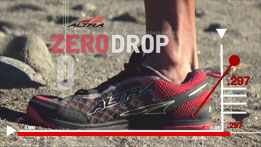The running shoe phenomenon propelled forward in the 70s with the iconic Nike Cortez. The shoe that Bill Bowerman made debuted in 1972 from Nike. This shoe as you can see, has a heel lift, designed to help “propel” the runner forward and to put less stress on the achilles tendon. (1)
Fast forward nearly 40 years when in 2009, Chris McDougall published his book, “Born to Run.” This book engendered the notion that barefoot or minimalist shoes were the most natural form for people to run in. This revolutionized the minimalist running industry, starting from the Vibram Five Fingers and giving the entire shoe industry another category of shoe to sell.
WHAT DOES THE RESEARCH SHOW?
First lets look at the research. “Born to Run” showed that Kenyans with minimally shod shoes or running barefoot was associated with forefoot landing. The theory was that the forefoot landing miminized the forces across the knees and forces aligned through the tibia and up the axial spine, minimizing forces directly on the knees and tibia.
Studies looking at forefoot running showed that changing to a forefoot strike may mitigate knee pain in patients and that a forefoot running technique can actually reduce forces across the knees. (3,4)
However looking at the research into barefoot shoes suggest that the shoe does not change the style of the running. So just because you wear minimalist type shoes, doesn’t necessarily mean that you will automatically change your running to a more forefoot strike. Therefore, running in minimalist shoes does not necessarily force you to run with a forefoot strike, but in reality may actually increase injuries. (5)
So how do you change to a forefoot running style if it isn’t the shoe?
First point
Second point
An increased cadence of 180 steps a minute may induce forefoot landing, something that born to run enthusiasts recommend and reduce joint forces across the knee. (6)
Looks like you actually have to train your body to do it. One well known method is the POSE running technique.
THE NEXT BIG THING IN SHOEWEAR?
Putting this all together, what is the next phase in the running shoe? I think we are seeing it already. The Nike Free series are a popular line of shoes that have different heel drops, ranging from 4mm to 8mm. But instead of providing a “barefoot feel” with little cushion, the sole provides ample cushion with a higher stack height.
Similarly, the ALTRA has a zero drop shoe with maximal cushioning to prevent the stress injuries from constant pounding on your metatarsals.
So, perhaps the optimal type of running wear is one that has minimal heel lift, a wide toe box but with maximal cushioning in order for you to feel the road but provide enough cushioning to help decrease the force across the foot and plantar fascia?
However, as the study has shown, the runner has a responsibility to relearn how to run. To lean slightly forward, and to increase step cadence. These are some cues that can help the recreational runner to run forefoot. Some though will need more formal running classes and gait analysis.
In fact, the ACSM has a recently published article on choosing shoe wear that is summarized here: (Selecting Running Shoes). (7)
SELECTING RUNNING SHOES (from ACSM)
REFERENCES
7. Vincent H, Vincent K. ACSM Information on…Selecting Running Shoes. http://www.acsm.org/docs/brochures/running-shoes.pdf





